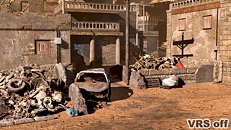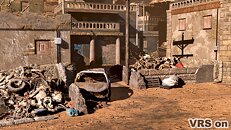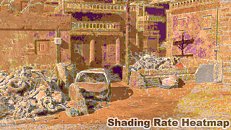Jul 27th, 2025 11:59 CDT
change timezone
Latest GPU Drivers
New Forum Posts
- What is the latest game you finished or 100% (64)
- 2022-X58/1366 PIN Motherboards NVME M.2 SSD BIOS MOD Collection (944)
- Which Linux flavor? (65)
- Does a bigger case actually run quieter if you’re using the same number of fans? (9)
- The Official Linux/Unix Desktop Screenshots Megathread (794)
- The TPU UK Clubhouse (26570)
- What phone you use as your daily driver? And, a discussion of them. (1805)
- Can't find vbios for Rx 470 (2)
- I5-3317u Throttling (9)
- ZHAOXIN Kaisheng KH-50000 Series (0)
Popular Reviews
- Noctua NF-A12x25 G2 PWM Fan Review
- Lian Li O11 Dynamic Mini V2 Review
- VAXEE XE V2 Wireless Review
- UPERFECT UMax 24 Review
- AQIRYS Sirius Pro Review
- MSI MPG B850I Edge Ti Wi-Fi Review
- Upcoming Hardware Launches 2025 (Updated May 2025)
- Sharkoon OfficePal C10 Review - Affordable and Decent
- AMD Ryzen 7 9800X3D Review - The Best Gaming Processor
- Sapphire Radeon RX 9060 XT Pulse OC 16 GB Review - An Excellent Choice
TPU on YouTube
Controversial News Posts
- Some Intel Nova Lake CPUs Rumored to Challenge AMD's 3D V-Cache in Desktop Gaming (140)
- AMD Radeon RX 9070 XT Gains 9% Performance at 1440p with Latest Driver, Beats RTX 5070 Ti (131)
- AMD's Upcoming UDNA / RDNA 5 GPU Could Feature 96 CUs and 384-bit Memory Bus (124)
- NVIDIA GeForce RTX 5080 SUPER Could Feature 24 GB Memory, Increased Power Limits (115)
- NVIDIA DLSS Transformer Cuts VRAM Usage by 20% (100)
- Intel "Nova Lake-S" Core Ultra 3, Ultra 5, Ultra 7, and Ultra 9 Core Configurations Surface (99)
- AMD Sampling Next-Gen Ryzen Desktop "Medusa Ridge," Sees Incremental IPC Upgrade, New cIOD (97)
- Intel CEO Confirms SMT To Return to Future CPUs (95)
Thursday, December 5th 2019

UL Benchmarks Outs 3DMark Feature Test for Variable-Rate Shading Tier-2
UL Benchmarks today announced an update to 3DMark, with the expansion of the Variable-Rate Shading (VRS) feature-test with support for VRS Tier-2. A component of DirectX 12, VRS Tier 1 is supported by NVIDIA "Turing" and Intel Gen11 graphics architectures (Ice Lake's iGPU). VRS Tier-2 is currently supported only by NVIDIA "Turing" GPUs. VRS Tier-2 adds a few performance enhancements such as lower levels of shading for areas of the scene with low contrast to their surroundings (think areas under shadow), yielding performance gains. The 3DMark VRS test runs in two passes, pass-1 runs with VRS-off to provide a point of reference; and pass-2 with VRS-on, to test performance gained. The 3DMark update with VRS Tier-2 test will apply for the Advanced and Professional editions.
DOWNLOAD: 3DMark v2.11.6846
DOWNLOAD: 3DMark v2.11.6846
Jul 27th, 2025 11:59 CDT
change timezone
Latest GPU Drivers
New Forum Posts
- What is the latest game you finished or 100% (64)
- 2022-X58/1366 PIN Motherboards NVME M.2 SSD BIOS MOD Collection (944)
- Which Linux flavor? (65)
- Does a bigger case actually run quieter if you’re using the same number of fans? (9)
- The Official Linux/Unix Desktop Screenshots Megathread (794)
- The TPU UK Clubhouse (26570)
- What phone you use as your daily driver? And, a discussion of them. (1805)
- Can't find vbios for Rx 470 (2)
- I5-3317u Throttling (9)
- ZHAOXIN Kaisheng KH-50000 Series (0)
Popular Reviews
- Noctua NF-A12x25 G2 PWM Fan Review
- Lian Li O11 Dynamic Mini V2 Review
- VAXEE XE V2 Wireless Review
- UPERFECT UMax 24 Review
- AQIRYS Sirius Pro Review
- MSI MPG B850I Edge Ti Wi-Fi Review
- Upcoming Hardware Launches 2025 (Updated May 2025)
- Sharkoon OfficePal C10 Review - Affordable and Decent
- AMD Ryzen 7 9800X3D Review - The Best Gaming Processor
- Sapphire Radeon RX 9060 XT Pulse OC 16 GB Review - An Excellent Choice
TPU on YouTube
Controversial News Posts
- Some Intel Nova Lake CPUs Rumored to Challenge AMD's 3D V-Cache in Desktop Gaming (140)
- AMD Radeon RX 9070 XT Gains 9% Performance at 1440p with Latest Driver, Beats RTX 5070 Ti (131)
- AMD's Upcoming UDNA / RDNA 5 GPU Could Feature 96 CUs and 384-bit Memory Bus (124)
- NVIDIA GeForce RTX 5080 SUPER Could Feature 24 GB Memory, Increased Power Limits (115)
- NVIDIA DLSS Transformer Cuts VRAM Usage by 20% (100)
- Intel "Nova Lake-S" Core Ultra 3, Ultra 5, Ultra 7, and Ultra 9 Core Configurations Surface (99)
- AMD Sampling Next-Gen Ryzen Desktop "Medusa Ridge," Sees Incremental IPC Upgrade, New cIOD (97)
- Intel CEO Confirms SMT To Return to Future CPUs (95)



58 Comments on UL Benchmarks Outs 3DMark Feature Test for Variable-Rate Shading Tier-2
If the aim is to keep framerates above 60 @ 4K at all times, then it works very well at doing that.
..I'm sure if you looked hard enough you'd see where the cutbacks are but it's not obvious when in motion.
Whether it's different in motion or not I can't say, but the stills look identical.
Is this a feature that needs to be developed for by the game devs, or is this something that you just go into NV control panel and flip a switch?
1. on the power box there is some text there its still blurry but its just a little bit sharper? than the off pic
2. if you look at the buildings in the background from the top left in the gap where u see the building its noticeably sharper
3. near the car where there is a patch of smooth darker dirt its ever so slightly sharper
4. the wooden power pole near the car is noticeably sharper
Here's the UL post (with lossless screenshots):
benchmarks.ul.com/news/new-ways-to-test-variable-rate-shading-with-3dmark
Direct links:
benchmarks.ul.com/hwc/tmp/3dmark-vrs-feature-test-tier2-screenshot-vrs-off.png
benchmarks.ul.com/hwc/tmp/3dmark-vrs-feature-test-tier2-screenshot-vrs-on.png
The quality dip is as obvious as it was on the previous VRS test.
And since I'm about to plan to build a new PC, specifically targeting framerates, and have already been willing to drop from 4K@60 down to 1440p 144hz, I'm EXACTLY the targeted demographic.
Other areas:
The other junction box, the gas can, the hood of the car, the power pole, the walls, the window shutters, the trashbag, the columns, the ground texture in some spots.
Okay, I see what you mean. However, I'd suggest that it has zero effect whatsoever on visual experience, as the scene in it's entirety is well resolved with excellent detail. This sort of IQ reduction would only annoy gamers that like to put their quests aside and stare at walls. Proverbial paint drying stuff. Given that I had to have it pointed out to me, it's a clear example of an excellent sacrifice for higher fps.
First,there was multi res shading in shadow warrior 2,I usually ran the balanced setting that rendered 20% on each side at 1080p and the central 60% at 1440p.Noticeable in static image,not noticeable during gameplay.the game ran at pretty high framerates anyway.
then dlss,which it seems is really hard to do properly.played the whole control with dlss on and while for the most part it's doing an amazing job of keeping the IQ reasonably high,it's still got frequent glitches and bugs too where it takes too long to load when entering a new area or just plain doesn't recreate some objects.it's really good when it's doing what it's supposed to do,the problem is how inconsistent it is.when comparing static shots 960p dlss produces a tiny bit less jagged image and much less flickering than 1080p while still delivering about 10% more performance.but still,more bugs to work out than most of us would like to see.
with vrs it's easier and the performance gain is almost as high.seems like the best of all three by far.